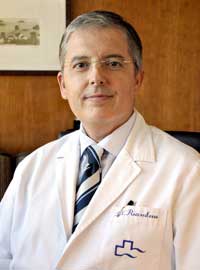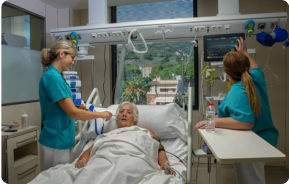

La necesidad actual de la Medicina de realizar tratamientos ambulatorios, reduciendo la estancia hospitalaria de los pacientes junto al importante desarrollo tecnológico de diversos tipos de terapias con láser ha hecho que se introdujeran estas técnicas que mejoran, sin lugar a dudas, los resultados terapéuticos.
Una plataforma láser cuenta con diversos tipos de láseres:
- El de CO2 que puede actuar:
- Como sustitutivo o complemento al bisturí por efecto de corte. Es recomendada su utilización en intervenciones de pacientes con tratamiento anticoagulante, tumores vasculares, riesgo de queloides, quemaduras, etc.
- Por su efecto de vaporización y coagulación, es recomendado en extirpación de tumores benignos, lesiones premalignas, inflamatorias y quísticas.
- Para realizar abrasiones o rejuvenecimiento cutáneo. En este caso, puede asociarse con el láser de Er-YAG.
En el tratamiento con láser para eliminar o resolver lesiones nos basamos en el concepto de fototermolisis selectiva, es decir, lesionar la estructura concreta sin dañar los tejidos circundantes. Para ello, precisamos trabajar con una longitud de onda que corresponda al pico de absorción del cromoforo contenido en la lesión y utilizar pulsos que sean más cortos que el tiempo de relajación térmica. Así:
- Para el tratamiento de lesiones vasculares como telangiectasias, varículas, lesiones congénitas (angiomas, angioqueratomas), lagos venosos, angiofibromas y tumores glómicos entre otros, podemos utilizar láser de Argón (488 – 514 nm), láseres de vapor de Cobre (578 nm) y Kripton (568 nm) Nd-YAG – KTP (532 nm) o lámparas flash (515 – 1200 nm) con un láser pulsado en el espectro infrarrojo cercano (1064 nm) con el que pueden tratarse vasos de hasta 3,5 mm de diámetro y profundidad de hasta 5mm.
- Para resolver lesiones pigmentadas, tanto congénitas (nevus, manchas café con leche) como adquiridas (efelides, lentigos benignos, melasmas, queratosis seborreicas), lesiones malignas como carcinomas basocelulares pigmentarios y tatujaes tanto tarumáticos, decorativos o cosméticos. Se pueden utilizar láser de Nd-YAG pulsado Q Switched (1064 nm) y Nd-YAG KTP (532 nm), láser Q – rubí (694 nm) alexandrita (755 nm) o de colorante pulsado (510 nm).
- Para el tratamiento del hirsutismo se han utilizado diversos sistemas láser como el de rubí, Nd-YAG o Alexandrita. También se han utilizado con éxito las lámparas flash y más recientemente el láser de diodos.
No es necesario disponer de todos estos sistemas, como vemos hay múltiples posibilidades y podemos utilizar un láser u otro dependiendo de la patología que queramos tratar, asimismo según las características del sistema y el método de aplicación obtendremos unos efectos determinados.
Para utilizar correctamente estos sistemas, sacar el máximo rendimiento y minimizar los efectos secundarios, es necesario que sean utilizados por un profesional especialista en técnicas láser que conozca perfectamente la física de la luz, las diversas patologías susceptibles de ser tratadas con láser y como interacciona la luz con el tejido al ser aplicado.
La plataforma debe disponer de un programa de seguridad de láser que incluirá los requisitos mínimos de seguridad y mantenimiento. El área de funcionamiento deberá tener una señalización de advertencia de los accesos. Además, habrá una señal luminosa en el exterior que se encenderá cuando los equipos estén funcionando.
El sistema eléctrico debe cumplir la normativa vigente para equipos médicos. Las superficies del área de tratamiento deberán ser de material antireflectante. No debe haber ventanas que comuniquen con el exterior. La protección ocular deberá tener la densidad óptica que corresponde a la longitud de onda específica del láser con el que estemos trabajando.
Las ventajas del tratamiento con láser son múltiples. Es un tratamiento en muchos casos único para alguna de las patologías enumeradas. Se realiza ambulatoriamente.
Si se precisa anestesia suele ser local. Es muy útil en pacientes en tratamiento con antiocoagulantes. Cirugía limpia con menor área de necrosis y postoperatorio menos traumático.
Una desventaja importante es el coste de los equipos y su mantenimiento. La necesidad de que su manejo sea por un profesional experto aunque en parte encarece el tratamiento, por otra parte, se rentabiliza ya que un experto en estos sistemas no necesita una batería de ellos, sino que dependiendo de la patología más frecuente a tratar selecciona el aparato más adecuado y variando los parámetros de tratamiento, hace que éste sea versátil y sea capaz de resolver diferentes patologías.































